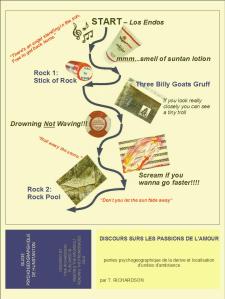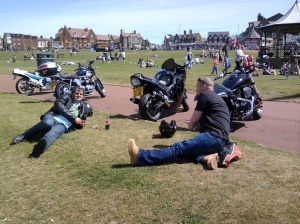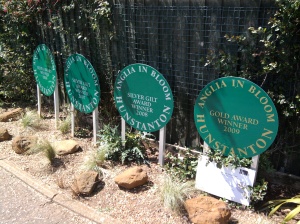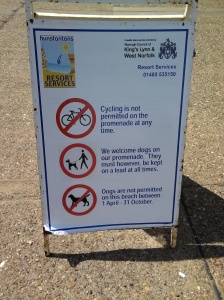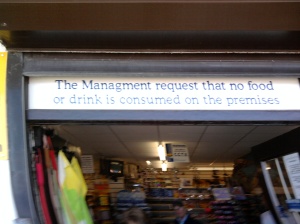The above film was shot in June 2011 in Hunstanton, Norfolk. A Microsoft Sensecam was used to shoot the film and it was edited in Windows Live Movie Maker . The camera on view in the film is a Lomo Diana F+
Posts Tagged ‘Tina Richardson’
A Psychogeographical Guide to Hunstanton Promenade
In Uncategorized on July 1, 2010 at 8:32 am
Guide Psychogeographique De Hunstanton
By Tina Richardson
“Progress is nothing other than breaking through a field where chance holds sway by creating new conditions more favorable to our purposes.” Guy Debord
This map is a Situationist-style map based on Guy Debord’s ‘Guide Psychogeographique De Paris’.
The images highlight various ambiances on the promenade at Hunstanton, Norfolk. The curved line challenges the linear form of the promenade, and suggests an alternative way of walking along the prom (as does starting at the end). The phenomenon represented here do not appear in the order they do in actual space (also, some are transient, some invented e.g. there is no troll). The red of Debord’s map has been replaced with blue to reflect the sea. The cream colour, which actually appears in many of the reproduced images of Debord’s map, is meant to represent the sand. The text includes: subjective comments, rock music lyrics, popular phrases, a reference to a fairy tale, etc. In this Guide Psychogeographique I have used full colour on the map section, unlike my previous one of the University of Leeds campus, which can be viewed here:
Guide Psychogeographique De University of Leeds
Please note: I would like to give my thanks to those at www.geograph.org.uk who let me use their images. Also, to James Cridland at http://james.cridland.net Much appreciated!
Please see my blogs on A Schizocartography of Hunstanton located here:
And my other Hunstanton ‘map’: The Collage Seaside
Bibliography:
Debord, Guy. 1996. ‘Theory of the Dérive’, Theory of the Dérive and Other Situationist Writings on the City, ed. by Libero Andreotti and Xavier Costa (Barcelona: Museu d’Art Contemporani de Barcelona). pp. 22-27.
For information on my other work, please go to: particulations
The Collage Seaside
In Uncategorized on June 21, 2010 at 9:00 amBy Tina Richardson
“Collage is simultaneously innocent and devious.” Colin Rowe and Red Koetter
The above schizocartographic image was made by cutting photos of Hunstanton from various brochures and leaflets that advertise the seaside town. The pasted words and phrases are mostly popular terms that refer to seaside resorts, but were actually taken from the adverts of businesses or organisations located in the area. The other terms refer to the analysis and theory of urban space and have been added digitally. The quotes are comments on urban space by the following:
1 – Iain Sinclair
2 – Brian Jarvis
3 – Felix Guattari
4 – David Harvey
5 – Henri Lefebvre
This ‘map’ has been named after the book Collage City by Colin Rowe and Fred Koetter.
Bibliography:
Row, Colin and Fred Koetter. 1987. Collage City (Cambridge, Massachusetts: The MIT Press).
For information on my other work, please go to: particulations
“Out of nothing in the middle of nowhere.”: a Schizocartography of Hunstanton
In Uncategorized on June 14, 2010 at 10:09 amPart 2 – Leaving the Promenade
By Tina Richardson
Part 1 of this blog highlighted the experiences and findings resulting from walking Hunstanton promenade. This part responds to the urban décor that I came across upon leaving the promenade from the north end via The Green. I have used this décor as a means of both reading and (re)writing the urban space.
The Green
The Green in Hunstanton is edged on the North East by The Golden Lion Hotel and the Town Hall:
The above image shows the hotel on the left and next to it the Town Hall, which now appears to be the Tourist Information Centre, at least at the front section (I remember playing in a piano competition in the hall at the back as a child). The Cross on the Green, which no longer appears to be a cross, is meant to be the remains of an ancient village cross. According to Ken Arnott, in Hunstanton: The Story of a Small Norfolk Seaside Resort, it was repositioned on The Green at the time The Golden Lion was built (1846).
Despite these noteworthy buildings, built in the famous Carr Stone, my attention was drawn to the bikers that frequent The Green on sunny days.
Easy Rider
Hunstanton, as many with seaside resorts, is known for its visits from bikers. From what I can tell they are welcomed by most people and are not considered by the locals to be a problem. In fact, my elderly parents used to wander down to The Green especially to look at the bikes. Motorcycle Rallys are regularly held in Hunstanton. This form of appropriation of space is quite interesting and I will endeavour to follow it up in a future blog. These two chaps not only kindly let me take their photo but also let me chat to them.
They were mates and came from Peterborough. They had been coming to Hunstanton since the 1980s. One was a trucker and the other a psychiatric nurse. The trucker said he had brought his 18 year old daughter to Hunstanton on the back of his bike before. They ride a Honda Blackbird 1100 and Suzuki VZR 1800. The bikes were quite beautiful and motorbikes generally are clearly a major passion to the owners, as can be demonstrated in this youtube film which is 1 minute 35 seconds of someone simply admiring their bike through the lens of a camcorder and sharing it with the world:
Esplanade Gardens
The Esplanade Gardens follow on from The Green. I’m not sure exactly when they were completed but, according to Mary Rhodes, sometime after 1897. There is a memorial to the flood victims of 1953 in the gardens. It says: “This tablet records the names of those residents of South Beach who lost their lives in the great flood and tempest. 31 Jan 1953.”. I took a photo of the tablet, but the one shown at the link below is much better (please scroll down for image):
Having grown up in King’s Lynn (the largest nearby town) in the 1960s I remember my parents talking about the flood which hit the port and coastal area badly. In fact, in North Lynn you can still see the marks of the floodwater on the buildings: often reaching as high as the first floors of the terraced houses.
Dog Fouling
Needless to say, like the prom, the gardens has a large focus on owner/dog behaviour. Although I didn’t see many dogs around either area.
I did find this council document on fouling in Hunstanton. According to Councillor Brian Long: “Dog fouling is at best unsightly and unpleasant. At worst it can actually cause disease and blindness. Under this new order we will be much more able to take enforcement action against irresponsible dog owners. The majority of dog owners are responsible and dutifully clean up after their dog has fouled, but it is the small minority that make it unpleasant for everyone else.”
Images of the Gardens
Other photos I would like to include here are:
Anglia in Bloom: Hunstanton seems to have had a good run on winning ‘Anglia in Bloom’ recently:
The Victorian Fountain: I’m assuming this fountain is Victorian (it has an arts-and-crafts-movement feel about it) but I don’t seem to have any further information on it. No water was spurting from it on the day of my visit.
Plants in Boat Sculpture: One of the first things you see when entering the park is this interesting sculpture/plant pot. Initially I thought it was a bit ‘cheesy’, but the more I look at it the more I like it. In the background you can see the bowling green and some of the unique Hunstanton architecture.
Conclusion
I ended this part of my promenade walk when I arrived at the Salad Bowl cafe, just on from the Esplanade Gardens, where I had lunch. Outside the cafe were three memorial benches, two had signs on them:
I shall conclude this blog with a quote from Arnott’s text. Apparently, this appeared in an old guide of the town (or ‘village’ as it was at that time): “A village of mellow walls, chequered with warm colours and red valerian and toadflax. There, lovers of antiquity will linger, held by a medieval spell.”.
Bibliography:
Arnott, Ken. 2000. Hunstanton: The Story of a Small Norfolk Seaside Resort (King’s Lynn: Borough Council of King’s Lynn and West Norfolk).
Rhodes, Mary. Date Unknown. The Hunstanton Story: The First Fifty Years 1861-1911 (Warwick: Private Publication).
For information on my other work, please go to: particulations
“Out of nothing in the middle of nowhere.”: a Schizocartography of Hunstanton
In Uncategorized on June 9, 2010 at 9:22 amPart 1 – Walking the Promenade
A trip to ‘Sunny Hunny’
By Tina Richardson
Late morning on Wednesday June 2nd 2010 I set off from Northgate in Hunstanton (named after the local red Carr Stone – ‘honeystone’), Norfolk to explore the promenade. However, unlike John Betjeman I was unable to take the train from King’s Lynn railway station directly to Hunstanton (Hunst’on, as it is to the ‘locals’), as the line was closed in 1969:
The title of this blog – “Out of nothing in the middle of nowhere.” – refers to the phrase that is often used to describe Hunstanton’s origins: it sprung from a rural landscape and was developed for the sole purpose of turning it into a seaside resort. Schizocartography refers to the methods I use to highlight dominant power structures, while attempting to provide alternative narratives (often subjective) in text, image and map form.
I journeyed down the prom from the north to the south end and back again. Being one of the sunny days of the recent boost of sun, and also half-term, the prom and beach were quite busy. Although, since my walk was psychogeographically-oriented my remarks, as you will see, concentrate on what is often not noticed on a casual viewing.
Donut Heaven (or the Disneyfication of the Seaside)
While the kiss-me-quick quality of the 60s seaside resort has diminished, it has become an almost hyper-real space that is highly oriented around consumerism. The proliferation of signs is positively Baudrillardian, it was difficult not to be interpellated by them and I had to make a conscious effort to notice other stimuli.
I was particularly drawn to the notices that were prohibiting particular actions and behaviours. Here is a sample of some of those on the prom itself. I especially like the one that says “This area is for pony rides only. No kites, chairs, balls, inflatables, etc” and then pretends to be a council notice by writing (in marker pen) KL & WNBC on the bottom which stands for King’s Lynn and West Norfolk Borough Council:
Nevertheless, the deckchair hiring companies seemed to challenge this draconian approach and, in fact, do the opposite by allowing you to help yourself to the deckchairs, prior to paying for them:
Utilities Boxes
There appear to be a number of power boxes, serving the nearby outlets, within easy access of the prom. There were far too many to photograph, (even though it would be an interesting project to do so).
I looked for utility boxes on google and found this stylish one made by a company in the US. It might be an interesting idea for Hunstanton to fund an art project for blending the utility boxes in with their respective backgrounds. This will simultaneously turn them into a (tourist) feature unique to the resort.
This image has been reproduced by the kind permission of American Gas Products Inc www.americangasproducts.com
Liminal Spaces
A couple of interesting (lost) spaces caught my attention. The image I have called “Welcome to My Garden” was located between one of the large plastic childrens’ slides on the prom and the themed crazy golf course. The other, “Discrete Concrete”, was a nook under the ramp of the Surfside Cafeteria.
The deep topographer Nick Papadimitriou is often attracted to these in-between spaces. So, too, is Patrick Keiller as can be seen in his Robinson series of films.
(go to 45 seconds into the film to see an example of a liminal space – a portakabin at Elephant and Castle, London)
Nick Papadimitriou’s site: (films by John Rogers)
Past and Present
At one of the car parks adjacent to the prom is this road sign which appears within the car parking space, against the wall that divides the car park from the prom:
Douglas Bader, the famous pilot who crashed while doing aerobatics and lost both his legs, must have some connection to Hunstanton outside of his relationship to Norfolk (where he served in the RAF). However, following a quick search I am unable to find what this is.
There is a tourist notice nearby (headed “Hunstanton Past and Present: The Promenade”) which says: “The seafront from the Green to the fairground was developed during the 1920s and 1930s on land reclaimed from the sea.”.
According to The Hunstanton Story: The First Fifty Years 1861-1911 by Mary Rhodes: the first section of the prom was not built until 1879. The second section “was erected later, roomy shelters with long wooden seats all round the walls and an ornamental balcony on the roof were added. Convenient slopes and steps at each end gave access to the beach. Another refinement about this time was the drinking fountain on the Green at the head of the pier – a generous gift presented by Jamesina Waller.”
Conclusion
Hunstanton, a place I visited as a child in the 60s, has become infinitely more interesting due to my psychgeographical drift along its prom. It has also hugely improved as an urban space and resort in comparison to the slump it appeared to be in in the early 1980s. My schizocartography will continue with the second part of this blog which covers the area behind the prom at the North end.
Bibliography:
Rhodes, Mary. Date Unknown. The Hunstanton Story: The First Fifty Years 1861-1911 (Warwick: Private Publication).
For information on my other work please go to: particulations
